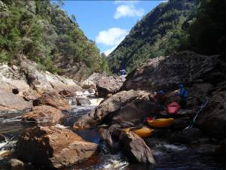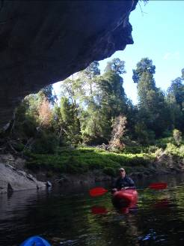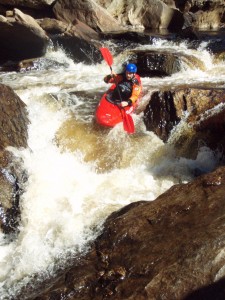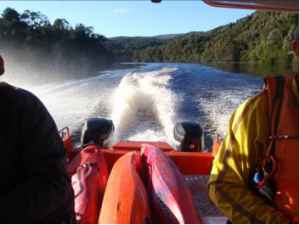Now that I live in the UK, one of the things I miss about Tasmania is the easy opportunity for a multi-day trip down a remote river. Although parts of Scotland and Wales are pretty remote, there’s not the same sense of wilderness. I think back to the three years between 1977 and 1979 when I paddled several Tasmanian wilderness rivers for the first time. It was something of a pioneering golden age, when it was still possible to make first descents of remote rivers. Several river systems were threatened by hydro-electric development, and the fight to save the Franklin River became a major political issue in Australia.
One river system that didn’t survive was the Pieman, which along with its major tributaries the Murchison and Macintosh Rivers is now a series of long narrow lakes on Tasmania’s west coast. I cried for its memory when I first drove over the new bridge that crosses Lake Murchison. The Pieman has a special place in my heart; in 1977 I paddled the Pieman for the first time, a wide-eyed boy joining the Derwent Canoe Club’s regular Easter trip. Only my friend Mouse was younger than me (he was 13 and I was 14) so it was a big step to paddle with the ‘grown ups’ – although the average age of the group was probably less than 20. My boat was a home-made Lettman Olymp, which worryingly began to leak almost as soon as we set off on the Murchison. No one had drybags, instead we packed our gear in several plastic garbage bags inside a hessian sack. The 65 km trip took 3 days through remote gorges with Grade 1 – 3 whitewater, interspersed with long flat-water reaches.
Adventures began almost immediately, when Flan wrapped his boat around a log at the base of a fall, snapping it in two. Luckily we were still close to civilization so he was able to climb out of the gorge and walk to Rosebery, a small mining town. I found the whole trip hard – my sleeping bag got wet so the nights were uncomfortable, my boat cracked up under the load and leaked profusely despite my attempts at repairs, and my back ached from 3 long days of paddling a heavy, leaking boat
Yet at the same time I absolutely loved the whole experience; camping on sandbanks or in rainforest glades amongst giant tree ferns, exploring tributary waterfalls, and running rapids with the added challenge of a laden boat and the knowledge that it was a long walk out if anything went wrong. All within the camaraderie and banter of the paddling group. Over the next few years I paddled the Pieman again along with several trips down the Franklin and a first descent of the Jane River in 1979. The Jane is a major tributary of the Franklin and is uncrossed by any roads. A friend drove us in along a 4WD track and then we walked the final 6 km to the river. We had no real idea what was in store for us, and made our way around siphons, through spectacular gorges and some extreme portages. It took us three days to reach the Franklin, and another day and a half to finish. The Jane has only been paddled a handful of times since then, after the access track was closed to protect the World Heritage values of the area.
I returned to the Franklin in 2009, 30 years since my first trip. It was a brilliant trip with good friends. Here are some photos.
There’s something about a wilderness river trip that touches some deep part of me – perhaps it’s a version of the archetypal ‘hero’s journey’ in which the protagonist leaves the ordinary world and, with the support of companions, faces a series of trials and opponents. The trials function on at least two levels. On the exterior level they challenge the hero’s skills and ingenuity. And more importantly on the interior level they test the hero’s character and reveal something profound about his or her very soul. Returning to the ordinary world the hero is changed, only to be shunned and misunderstood by those who stayed at home. At least that’s what happens in mythology. Perhaps the magic of wilderness paddling is simpler than that – it could just be the joy of getting away on a river with good friends.
I’m now starting to take my executive coaching clients into the wilderness, because its an even more powerful experience for people who spend most of their time in an office. The first trip was to Namibia – here’s the link if you want to learn more http://www.performance-1.co.uk/wilderness-executive-retreats
And if you’ve not seen the Facebook page, its an easy way to contribute your comments https://www.facebook.com/DiaryOfAMiddleAgedKayaker







